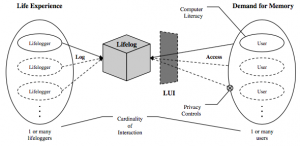
Type:
Master
Status: Completed
September 2015
Student: Daniel Cardozo
Nowadays lifelogging is increasingly becoming part of people’s everyday life. The continuous advancements in different sensing and information technologies are facilitating the application of lifelogging to several domains. These domains describe scenarios where human memory can be supported to recall information of past experiences. However, one of the main challenges of lifelogging concerns how to access information when this is located in complex and vast depositories of data called lifelogs. Without the appropriate user interface to interact with lifelogs, the retrieval and visualization of information becomes overwhelming. What’s more, the different applications of lifelogging pose diverse contexts and particular needs of information.
This thesis regards the construction of a classification scheme of lifelogging user interfaces. The approach of reference to the construction of the scheme was Faceted Analysis. This approach permitted to integrate different perspectives from which lifelogging user interfaces can be described. The domain where lifelogging is applied was defined as the main classification feature. The rest of features were derived from the combination of design principles of lifelogging systems and design goals for presentation and visualization of lifelogs. The criterion to define and develop these features was the scope of lifelogging user interfaces, which was defined in terms of their boundaries when supporting the synergy between human memory and lifelog. The result of this thesis was a classification scheme composed of seven features that allow characterizing lifelogging user interfaces for different application domains.
For more information contact: Evangelos Niforatos




